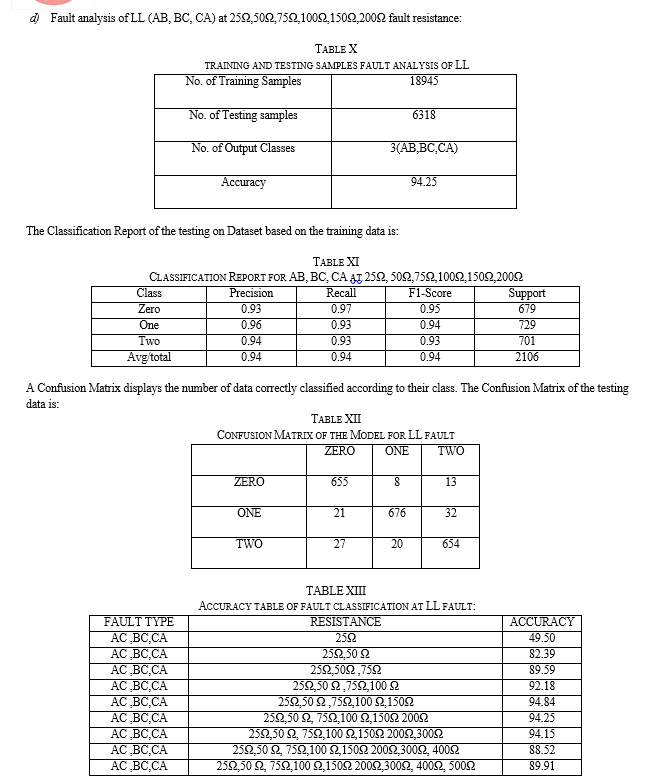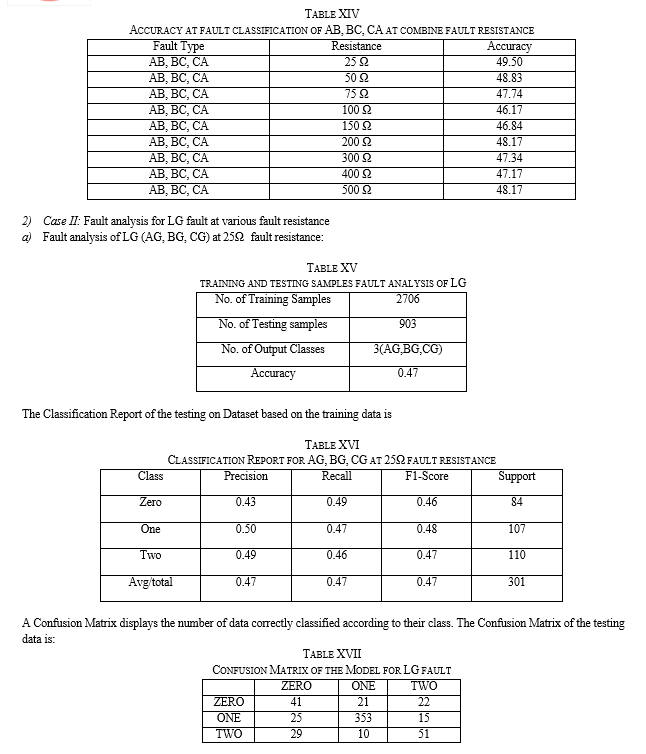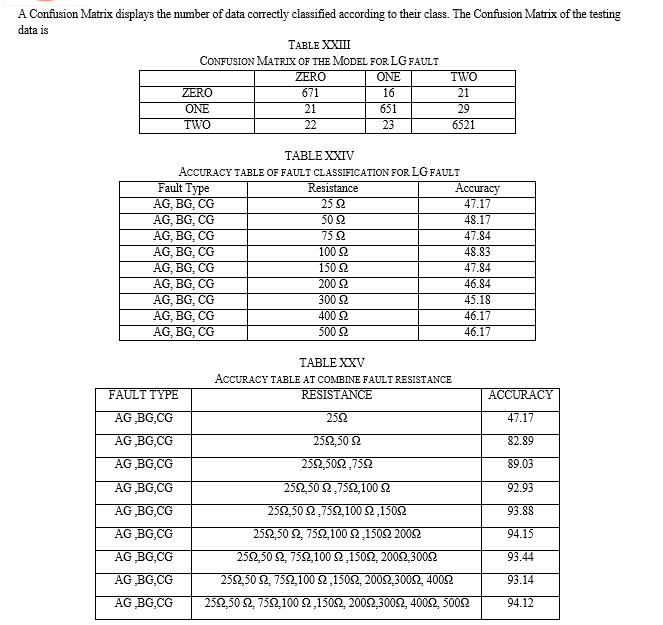Ijraset Journal For Research in Applied Science and Engineering Technology
- Home / Ijraset
- On This Page
- Abstract
- Introduction
- Conclusion
- References
- Copyright
Decision Tree Based Fault Classification for Transmission Line Analysis
Authors: Priti Choudhary, Dr. M. K. Bhaskar, Manish Parihar
DOI Link: https://doi.org/10.22214/ijraset.2023.56175
Certificate: View Certificate
Abstract
Transmission lines forms the backbone of the transmission and distribution networks which powers the nation. No modern society can imagine its existence without power supplies which runs everything ranging from consumer electronics to bullet trains. This research paper focuses on classifying faults on electric power transmission lines. fault classification has been achieved by using decision tree and study on their result is done. The simulation studies have been carried out by using MATLAB fuzzy-logic toolbox.
Introduction
I. INTRODUCTION
This document is a template. For questions on paper guidelines, please contact us via e-mail. The use of high capacity electrical generating power plants and concept of grid, i.e. synchronized electrical power plants and geographical displaced grids, required fault detection and operation of protection equipment in minimum possible time so that the power system can remain in stable condition. The faults on electrical power system transmission lines are supposed to be first detected and then be classified correctly and should be cleared in least fast as possible time. The protection system used for a transmission line can also be used to initiate the other relays to protect the power system from outages.
A good fault detection system provides an effective, reliable, fast and secure way of a relaying operation. Therefore, a transmission system should have design in accordance with the process of fault classification where it could be classifying easily and it would be possible to isolate the faulty section easily. Application of machine learning algorithms on the transmission line for fault classification and location identification has been explored in many research. Decision tree is one of the most popular supervised learning models for knowledge discovery. Decision trees are used to make decisions for the unseen cases with the help of the model build with the trained classes.
II. DECISION TREE
The first applications of DT in power systems were concerned with voltage security assessment. Transient stability analysis, power transformer protection and high impedance fault detection. This method provides a useful tool for fault analysis independent of the protection system. DTs that utilize voltage and current phasors as predictor variables and the target variable is the fault point.
DT is constructed in a top-down recursive divide-and-conquer manner. Each tree consists of many nodes. These nodes are divided into two kinds: internal nodes and terminal nodes. Each internal node is generated from another internal node and is surely generator of two or many internal or terminal nodes. Terminal node also known as leaf node is generated from an internal node but does not generate any node and as compared to other algorithms decision trees requires less effort for data preparation during pre-processing. It does not require normalization of data and scaling of data as well.
Missing values in the data also does not affect the process of building a decision tree to any considerable extent. Decision trees give a straightforward visualization of data. Figure 2.1 illustrates an example of a decision tree.

A. Flowchart & Algorithm
Dataset was divided into two datasets (75%/25%, training/testing) to avoid any bias in training and testing. Of the data, 75% was used to train the ML model, and the remaining 25% was used for testing the performance of the proposed activity classification system. Algorithm of Decision Tree:
- Step 1 - Creating a Power Transmission Line Models in MATLAB Simulink, obtaining data for various types of faults by manually adjusting the resistances; and saving the fault data in an MS-Excel File.
- Step 2 - Importing the libraries and packages in Google Colab.
- Step 3 - Mounting the fault data to Google Colab server.
- Step 4 - Merging all the data into a 2D Data Structure (Data Frame)
- Step 5 - Finding all entries of unique fault types and assigning class labels to all types of faults.
- Step 6 -Separating/ Splitting the train data and test data, i.e., current values and fault types by specifying division of all data (75:25).
- Step 7 - Importing Random Forest Classifier with specific estimators and depth.
- Step 8 - Fitting the data into the compiled model, i.e., training the model using the initially defined parameters.
- Step 9 - Training the model on the given set of data and testing on the other set of data separated out from the original data.
- Step 10-Predicting the values using the trained model and finding the accuracy based on how many times the data was predicted correctly.
- Step 11-Print the Accuracy Score, Classification Report and Confusion Matrix of the training process.
III. DESIGNING OF DECISION TREE MODEL
We have developed our own model based on decision tree architecture, and have used it to train the standard dataset values without any pre-processing, i.e., the input data have not been manipulated. The sample data set of these numbers are as shown below







Conclusion
Decision tree approach has been presented for the classification of different types of fault faults. Simulation was carried out on a 400kV, 3 phase and 300km line to support the results of the proposed technique for getting dataset of different types of fault current. To improve the accuracy of the fault diagnosis, especially in case of network topology variations, random forest (RF) containing DTs is used to increase robustness of diagnosis. the proposed technique gives quick, correct, robust fault classification of the LL, LG type of short circuit event occur in transmission line using data collected at post fault current. Uniqueness of this technique is that large no data is collected to classify different type of fault; optimized value of random forest classifier is used to improve the accuracy of model to classify different type of faults. The simulation result shows that maximum accuracy for LG fault classification is (94.15%) for LL fault classification is (94.84%).
References
[1] K. Chen, C. Huang, J. He, \"Fault detection classification and location for transmission lines and distribution systems: a review on the methods\", High Voltage IET, vol. 1, no. 1, pp. 25-33, April 2016. [2] A. Prasad, J. B. Edward, K. Ravi, \"A review on fault classification methodologies in power transmission systems: Part-I\", Journal of Electrical Systems and Information Technology, 2017. [3] A. Prasad, J. B. Edward, K. Ravi, \"A review on fault classification methodologies in power transmission systems: Part-II\", Journal of Electrical Systems and Information Technology, 2016. [4] K. Zimmerman, D. Costello, \"Impedance-based fault location experience\", Proc. 58th Annu. Conf. Protect. Relay Eng., pp. 211-226, April 2005. [5] G. Song, J. Suonan, Y. Ge, \"An accurate fault location algorithm for parallel transmission lines using one-terminal data\", Elect. Power Energy Syst., vol. 31, no. 23, pp. 124-129, Feb./Mar. 2009. [6] E. E. Ngu, K. Ramar, \"Combined impedance and traveling wave based fault location method for multi-terminal transmission lines\", Elect.Power Syst. Res., vol. 33, no. 10, pp. 1767-1775, Dec. 2011. [7] A. Capar, A. B. Arsoy, \"A performance oriented impedance based fault location algorithm for series compensated transmission lines\", Electrical Power and Energy Systems, vol. 71, pp. 209-214, 2015. [8] C. Fan, X. Du, S. Li, and W. Yu, “An adaptive fault location technique based on PMU for transmission line,” in Proceedings of the IEEE Power Engineering Society General Meeting (PES ’07), pp. 1–6, June 2007. [9] L. R. J. De, V. Centeno, J. S. Thorp, A. G. Phadke, \"Synchronized Phasor Measurement Applications in Power Systems\", IEEE Transactions on Smart Grid, vol. 1, no. 1, pp. 20-27, 2010. [10] Ghosh Debomita, Kumar Chandan, T. Ghose, D.K. Mohanta, \"Performance Simulation of Phasor Measurement Unit for Wide Area Measurement System\", Proceedings of international conference on control instrumentation energy and communication (CIEC-2014), pp. 297-300, 31 Jan.-02 February 2014. [11] O Altay, E Gursoy, O. Kalenderli, Single end travelling wave fault location on transmission systems using wavelet analysis[C]//High Voltage Engineering and Application (ICHVE), pp. 1-4, 2014. [12] Istrate, Marcel, et al. \"Single-phased fault location on transmission lines using unsynchronized voltages.” Advances in Electrical and Computer Engineering pp. 51-56, 2009. [13] P. Chen, B. Xu, J. Li, \"The optimized combination of fault location technology based on traveling wave principle\", Proc. Asia-Pacific Power Energy Eng. Conf., pp. 1-5, 2009. [14] V. Kale, S. Bhide, P. Bedekar, \"Fault Location Estimation Based on Wavelet Analysis of Traveling Waves\", Power and Energy Engineering Conference (APPEEC), pp. 1-5, March 2012. [15] Haike Liu , Tao Jia, “ Improved traveling wave based fault location scheme for transmission lines”, in Proceeding of the Electric Utility Deregulation and Restructuring and Power Technologies (DRPT), pp. 1– 6, March 2016. [16] Özkan Altay, Ekrem Gürsoy, “Travelling wave fault location on hybrid power lines”, IEEE International Conference on High Voltage Engineering and Application (ICHVE-2016), pp. 1 -4, 29 December 2016. [17] R. J. Hamidi, H. Livani, \"Traveling wave-based fault location algorithm for hybrid multi-terminal circuits\", IEEE Transactions on Power Delivery, vol. 32, pp. 135- 144, Feb. 2017. [18] Yu Liu , Sakis Meliopoulos, “Protection and fault locating method of series compensated lines by wavelet base energy traveling wave” , Power & Energy Society General Meeting, pp 1 – 5, July 2017. [19] Yanhui Xi , Zewen, Li “ Fault location based on travelling wave identification using an adaptive extended Kalman filter”, IET Generation, Transmission & Distribution, vol. 12,pp. 1314 -1322, 2018. [20] Jana, Soumyadip, Nath, Sudipta, Dasgupta, Aritra, 2012. Transmission line fault classification based on wavelet entropy and neural network. Int. J.Electr. Eng. Technol. 3 (July–September (2)), 94–102. [21] Hasabe, R.P., Vaidya, A.P., 2014a. Detection and classification of faults on 220 kv transmission line using wavelet transform and neural network.Int. J. Smart Grid Clean Energy 3 (July (3)), 283–290. [22] M. Choudhury, A. Ganguly, \"Transmission line fault classification using discrete wavelet transform\", Energy Power and Environment: Towards Sustainable Growth (ICEPE) 2015 International Conference on, pp. 1-5, 2015. [23] Jamil, M., Sharma, S.K., Singh, R., “Fault detection and classification in electrical power transmission system using artificial neural network”, SpringerPlus, 2015, 4, (334), pp. 1–13. [24] P. Ray, D. P. Mishra, S. Mohaptra, \"Fault classification of a transmission line using wavelet transform & fuzzy logic\", Proc. IEEE 1st Int. Conf. Power Electron. Intell. Control Energy Syst. (ICPEICES), pp. 1-6, Jul. 2016. [25] P. Ray, D. Prasad, \"Application of Wavelet Technique for Fault Classification in Transmission Systems\", Procedia Computer Science Elsevier, vol. 92, pp. 78-83, 2016. [26] S.A. Gafoor, P.V. Ramana Rao, \"Wavelet based fault detection classification and location in transmission line\", Power and Energy Conference PECon \'06 IEEE International, vol. 28, pp. 114-118, 2006. [27] T. Lobos, P. Kostyla, J. Pospieszna, MJaroszewski, Location of FaultsOn Transmission Lines Using Wavelet Transforms, International Conference on High Voltage Engineering and Application, November9-13, 2008, pp: 633-636. [28] P K Murthy, J Amarnath, S Kamakshiah et al., \"Wavelet transform approach for detection and location of fault HVDC system[C]\", Proceedings of 2008 IEEE Region 10 and the Third International Conference on Industrial and Information Systems, pp. 1-6, December 8-10, 2008. [29] B. R. Reddy, M. V. Kumar, M. Suryakalavathi et al., \"Fault detection classification and location on transmission lines using wavelet transform\", the proceedings of the 2009 Annual Report Conference on Electrical Insulation and Dielectric Phenomena, pp. 409-411, 2009. [30] Zhengyou He, Ling Fu, Sheng Lin, and Zhiqian Bo, \"Fault detection and classification in EHV transmission line based on wavelet singular entropy, \"IEEE Trans. Power Del, vol. 25, no. 4, 2010, pp. 2156-2163. [31] A. Yadav, A. Swetapadma, \"A novel transmission line relaying scheme for fault detection and classification using wavelet transform and linear discriminant analysis\", Ain Shams Engineering Journal, 2014. [32] Cecati C, Razi K. Fuzzy-logic-based high accurate faultclassification of single and double- circuit power transmission lines. Sorrento: International Symposium on PowerElectronics, Electrical Drives, Automation and Motion,IEEE Conference Publications. 2012 Jun 20-22. p. 883–9. [33] R. C. Mishra, P. M. Deoghare, C. Bhale, S. Lanjewar, \"Wavelet Based Transmission Line Fault Classification And Location\", IEEE International Conference on Smart Electric Grid (ISEG), pp. 1-5. [34] Majid Jamil, Rajveer Singh, Sanjeev Kumar Sharma, \"Fault identification in electrical power distribution system using combined discrete wavelet transform and fuzzy logic\", Journal of Electrical Systems and Information Technology, vol. 2, pp. 257-267, 2015. [35] N. A. Sundaravaradan , Rounak Meyur , P. Rajaraman , “A wavelet based novel technique for detection and classification of parallel transmission line faults” , International Conference on Power and Embedded System (SCOPES) – 2016, Vol. 2, pp. 1951 - 1955 , 2016. [36] J F Martinez-Canales, C Alvarez and J V Valero, “A REVIEW OF THE INCIDENCE OF MEDIUM AND HIGH VOLTAGE OVEHEAD ELECTRIC POWER LINES IN CAUSING FOREST FIRES,” IEEE 14th International Conference and Exhibition on Electricity Distribution (CIRED). Part 1: Contributions. (IEEE Conf. Publ. No. 438), (Volume:3 ), pp. (27/1-27/5), Birmingham 02 Jun 1997-05 Jun 1997. [37] S. Kirubadevi, S. Sutha, “Wavelet based transmission line fault identification and classification”, International Conference on Computation of Power Energy Information and Communication (ICCPEIC) – 2017, pp. 737 – 741, 2017. [38] J.R. Quinlan, “Induction of Decision Trees,” Machine Learning, vol. 1, no. 1, pp. 81-106, 1986. [39] G. M.Weiss, “Mining with rarity: A unifying framework,” ACM SIGKDD Explor. Newslett., vol. 6, no. 1, pp. 7–19, Jun. 2004. [40] N. V. Chawla, N. Japkowicz, and A. Kolcz, Eds., Special Issue Learning Imbalanced Datasets, SIGKDD Explor. Newsl., vol. 6, no. 1, 2004. [41] W.-Z. Lu and D.Wang, “Ground-level ozone prediction by support vector machine approach with a cost-sensitive classification scheme,” Sci. Total. Enviro., vol. 395, no. 2-3, pp. 109–116, 2008. [42] Y.-M. Huang, C.-M. Hung, and H. C. Jiau, “Evaluation of neural networks and data mining methods on a credit assessment task for class imbalance problem” Nonlinear Anal. R. World Appl., vol. 7, no. 4, pp. 720–747, 2006. [43] D. Cieslak, N. Chawla, and A. Striegel, “Combating imbalance in network intrusion datasets” in IEEE Int. Conf. Granular Comput., 2006, pp. 732–737. [44] M. A. Mazurowski, P. A. Habas, J. M. Zurada, J. Y. Lo, J. A. Baker, and G. D. Tourassi, “Training neural network classifiers for medical decision making: The effects of imbalanced datasets on classification performance,” Neural Netw., vol. 21, no. 2–3, pp. 427–436, 2008. [45] A. Freitas, A. Costa-Pereira, and P. Brazdil, “Cost-sensitive decision trees applied to medical data,” in Data Warehousing Knowl. Discov. (Lecture Notes Series in Computer Science), I. Song, J. Eder, and T. Nguyen, Eds., [46] K. Kilic¸,O¨ zgeUncu and I. B. Tu¨rksen, “Comparison of different strategies of utilizing fuzzy clustering in structure identification,” Inf. Sci., vol. 177, no. 23, pp. 5153–5162, 2007. [47] Ferrero, A., Sangiovanni, S. and Zappitelli, E. (1995), ‘A fuzzy-set approach to fault-type identification in digital relaying’, IEEE Transactions on Power Delivery 10(1), 169–175. [48] Kumar, S. (2014), ‘Discrimination of faults and their location identification on a high voltage transmission lines using the discrete wavelet transform’, International Journal of Education and Applied Research 4, 107–111. [49] Das, B. and Reddy, J. V. (2005), ‘Fuzzy-logic-based fault classification scheme for digital distance protection’, IEEE Transactions on Power Delivery 20(2), 609–616. [50] Mahanty, R. and Gupta, P. D. (2007), ‘A fuzzy logic based fault classification approach using current samples only’, Electric Power Systems Research 77(5), 501–507. [51] G.-T. Gwak, S.-H. Ahn, J.-h. Kim, Y.-s. Weon, and O.-Y. Kwon, “Prediction model for the risk of scapular winging in young women based on the decision tree,”Physical Therapy Korea, vol. 27, no. 2, pp. 140–148, 2020 [52] Cecati, C. and Razi, K. (2012), Fuzzy-logic-based high accurate fault classification of single and double-circuit power transmission lines, in ‘Proceedings of the International Symposium on Power electronics, electrical drives, automation and motion’, IEEE, pp. 883–889 [53] Shashi, R., Neelam, L., Nidhi, C., Richa, N. and Ramesh, P. (2012), ‘Fuzzy-logic- based fault classification for transmission line protection’, International Journal of Research in Engineering and Applied Sciences 2(2), 281–291. [54] Samantaray, S. (2013), ‘A systematic fuzzy rule based approach for fault classification in transmission lines’, Applied Soft Computing 13(2), 928–938. [55] Amir Ahmad ,Ourooj Safi , Sharaf Malebary (2021),Decision Tree Ensembles to Predict Coronavirus Disease 2019’ ,Hindawi Complexity Volume 2021.
Copyright
Copyright © 2023 Priti Choudhary, Dr. M. K. Bhaskar, Manish Parihar. This is an open access article distributed under the Creative Commons Attribution License, which permits unrestricted use, distribution, and reproduction in any medium, provided the original work is properly cited.

Download Paper
Paper Id : IJRASET56175
Publish Date : 2023-10-16
ISSN : 2321-9653
Publisher Name : IJRASET
DOI Link : Click Here
 Submit Paper Online
Submit Paper Online

